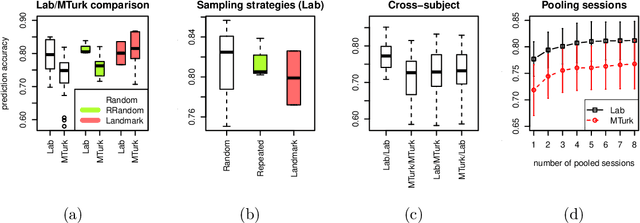Felix Wichmann
How Aligned are Different Alignment Metrics?
Jul 10, 2024Abstract:In recent years, various methods and benchmarks have been proposed to empirically evaluate the alignment of artificial neural networks to human neural and behavioral data. But how aligned are different alignment metrics? To answer this question, we analyze visual data from Brain-Score (Schrimpf et al., 2018), including metrics from the model-vs-human toolbox (Geirhos et al., 2021), together with human feature alignment (Linsley et al., 2018; Fel et al., 2022) and human similarity judgements (Muttenthaler et al., 2022). We find that pairwise correlations between neural scores and behavioral scores are quite low and sometimes even negative. For instance, the average correlation between those 80 models on Brain-Score that were fully evaluated on all 69 alignment metrics we considered is only 0.198. Assuming that all of the employed metrics are sound, this implies that alignment with human perception may best be thought of as a multidimensional concept, with different methods measuring fundamentally different aspects. Our results underline the importance of integrative benchmarking, but also raise questions about how to correctly combine and aggregate individual metrics. Aggregating by taking the arithmetic average, as done in Brain-Score, leads to the overall performance currently being dominated by behavior (95.25% explained variance) while the neural predictivity plays a less important role (only 33.33% explained variance). As a first step towards making sure that different alignment metrics all contribute fairly towards an integrative benchmark score, we therefore conclude by comparing three different aggregation options.
Estimation of perceptual scales using ordinal embedding
Aug 21, 2019



Abstract:In this paper, we address the problem of measuring and analysing sensation, the subjective magnitude of one's experience. We do this in the context of the method of triads: the sensation of the stimulus is evaluated via relative judgments of the form: "Is stimulus S_i more similar to stimulus S_j or to stimulus S_k?". We propose to use ordinal embedding methods from machine learning to estimate the scaling function from the relative judgments. We review two relevant and well-known methods in psychophysics which are partially applicable in our setting: non-metric multi-dimensional scaling (NMDS) and the method of maximum likelihood difference scaling (MLDS). We perform an extensive set of simulations, considering various scaling functions, to demonstrate the performance of the ordinal embedding methods. We show that in contrast to existing approaches our ordinal embedding approach allows, first, to obtain reasonable scaling function from comparatively few relative judgments, second, the estimation of non-monotonous scaling functions, and, third, multi-dimensional perceptual scales. In addition to the simulations, we analyse data from two real psychophysics experiments using ordinal embedding methods. Our results show that in the one-dimensional, monotonically increasing perceptual scale our ordinal embedding approach works as well as MLDS, while in higher dimensions, only our ordinal embedding methods can produce a desirable scaling function. To make our methods widely accessible, we provide an R-implementation and general rules of thumb on how to use ordinal embedding in the context of psychophysics.
Comparison-Based Framework for Psychophysics: Lab versus Crowdsourcing
May 17, 2019



Abstract:Traditionally, psychophysical experiments are conducted by repeated measurements on a few well-trained participants under well-controlled conditions, often resulting in, if done properly, high quality data. In recent years, however, crowdsourcing platforms are becoming increasingly popular means of data collection, measuring many participants at the potential cost of obtaining data of worse quality. In this paper we study whether the use of comparison-based (ordinal) data, combined with machine learning algorithms, can boost the reliability of crowdsourcing studies for psychophysics, such that they can achieve performance close to a lab experiment. To this end, we compare three setups: simulations, a psychophysics lab experiment, and the same experiment on Amazon Mechanical Turk. All these experiments are conducted in a comparison-based setting where participants have to answer triplet questions of the form "is object x closer to y or to z?". We then use machine learning to solve the triplet prediction problem: given a subset of triplet questions with corresponding answers, we predict the answer to the remaining questions. Considering the limitations and noise on MTurk, we find that the accuracy of triplet prediction is surprisingly close---but not equal---to our lab study.
 Add to Chrome
Add to Chrome Add to Firefox
Add to Firefox Add to Edge
Add to Edge